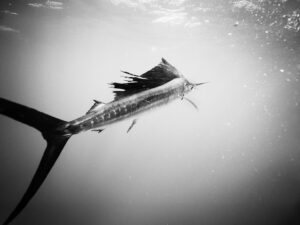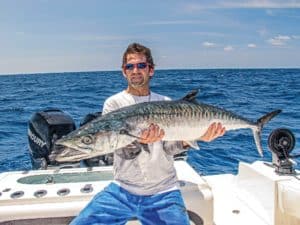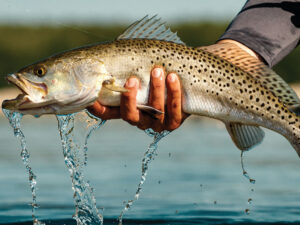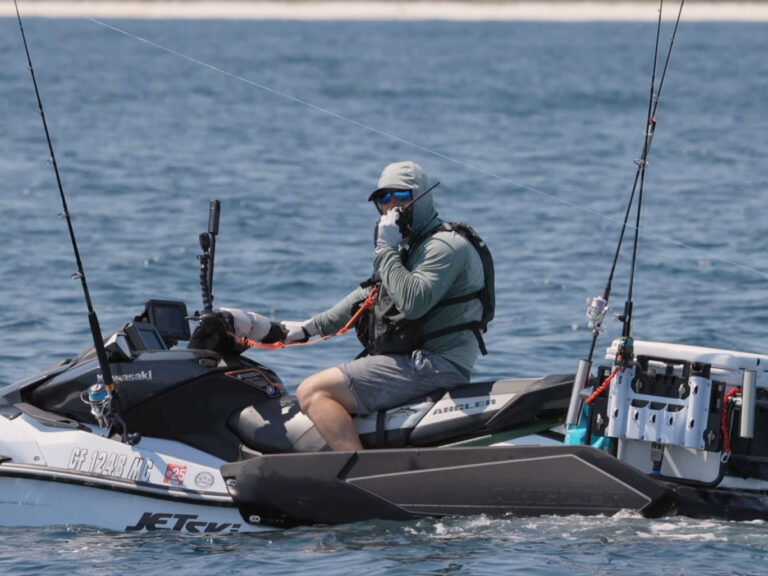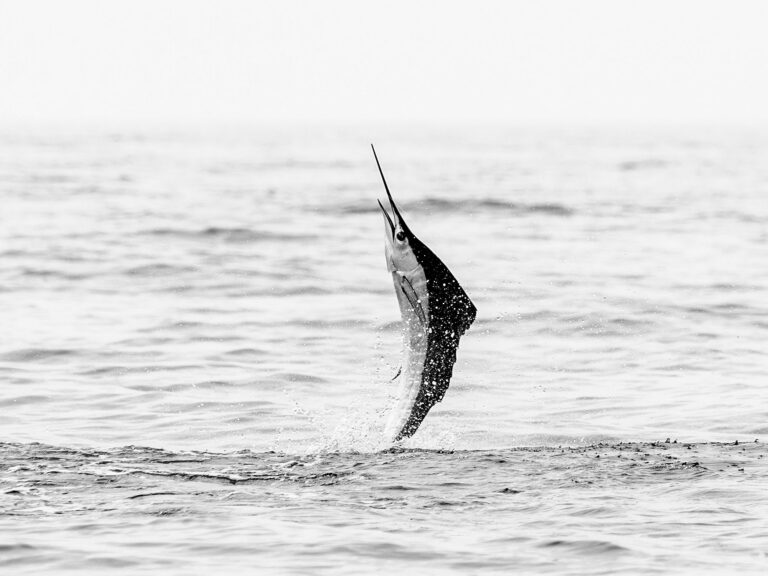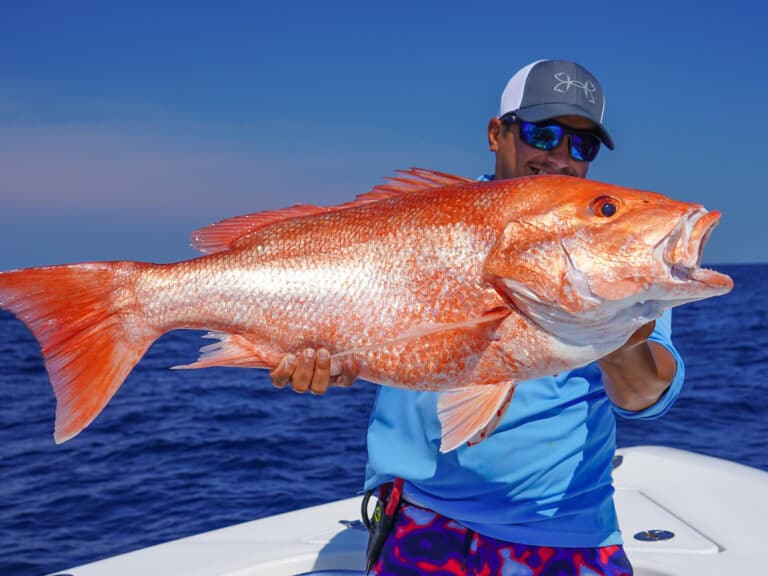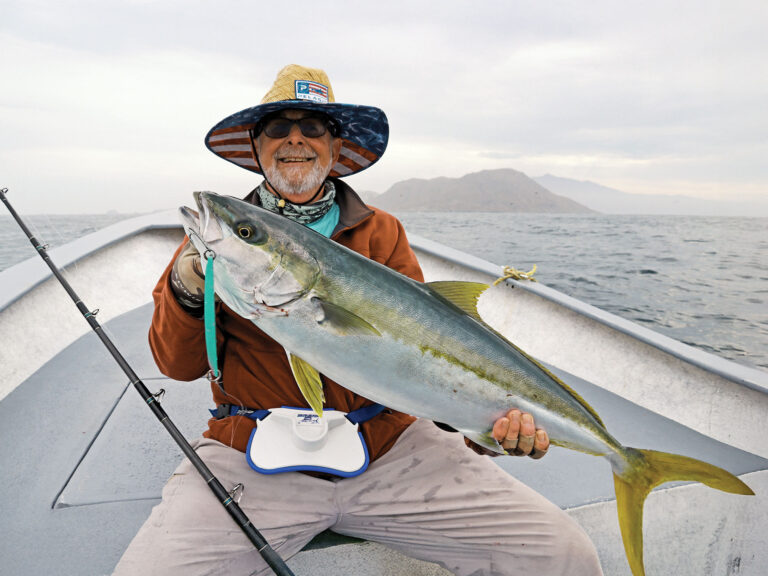
EYE ON THE PRIZE: The Bahamas have enticed many anglers to try to catch their first bonefish-including the author.
Photo: Sam Talarico/Talaricophotography.com
Ice blanketed the football field outside Saugatuck Elementary in Westport, Connecticut, and nearby a couple kids sped sleds down a hill. Meanwhile, I studied the snow for a school of imaginary bonefish in the end zone and fired a cast through the eight-knot wind.
Dressed in jeans, a fleece jacket and a ski hat, Lou Tabory stood to my left and coached my casts behind polarized sunglasses.
Not that casting a fly rod was anything new to me. I had been knee-deep in trout streams, fly rod in hand, since I was a teenager. And I can hold my own with anyone drifting nymphs or dropping dry flies, but in the past few years I’ve turned my attention to the salt.

| |BONE-A-FIDE: After landing his first bonefish, the author is all smiles – and relieved. Photo: John Frazier| After zeroing in on striped bass and bluefish I decided it was time for a true test-a Bahamas bonefish. That’s why I enlisted the help of Lou-a friend, colleague and possibly the best fly caster on the planet.
My make-believe fly just missed the frozen school. “Is the wind down there as tough as I’ve heard?” I asked.
Lou smiled and laughed. “Sometimes it’s worse,” he said. “But the wind can actually help you get closer to the fish.”
“Let’s hope.”
Bonefish bound
Earlier in the year I had made a list of top bonefish destinations and pinned it to my wall-Seychelles, the Keys, Belize and so on. But in the end, I selected a country so well known for bonefish that it put the species on its dime: the Bahamas.
Great. Now which island?
I narrowed it down to Andros and Abaco. Eventually I settled on the Abaco Beach Resort & Boat Harbour, in Marsh Harbour, because there was not only the promise of lots of bones but big ones, too. I would fish two full days on Friday and Saturday and a half-day on Sunday. I had roughly 20 hours to catch my first bonefish.
The clock started ticking when Captain Jody Albury, a young guide from Abaco, pushed his skiff into the Marls-a 400-square-mile stretch of mud-and-marsh-bottomed flats on the west side of the island. Jody, who has been guiding for three years, is good company, but, as I would learn, serious and straightforward about helping you catch fish and not afraid to point out your mistakes. Sitting across from me on the bow deck was John Frazier, the photo editor of Fly Fishing in Salt Waters magazine.
“Why don’t you take the first shot,” John offered, as Jody motored to the first spot. “You traveled farther.”

| |SMALL TOWN: Edmund “Town” Williams shows off the author’s fish before releasing it. Photo: Colin Kearns|
Stepping onto the casting deck I tried to block out distractions and thought about Lou’s advice. On the backcasts, don’t drop the rod tip too low, otherwise the wind will devour that open loop in your line. With 50 feet of line coiled at my feet and ready to shoot, I kept my eyes locked on the water, scanning for shadows. Jody poled the skiff for about 200 yards before we crept into a small cove. An almost-complete circle of red mangroves fenced us in like barbed wire.
“I got fish,” Jody called.
They were hard to miss. Just 20 feet away about 25 silver-flanked fish nosed along the flat, so close I could see their eyes. In a fit of bonefish fever, I rushed my cast. My tan No. 4 Puff splashed down in the middle of the school, and the fish reacted as if a meteorite had just landed in their midst. Minutes later we saw more fish. I made a better cast, but a fish puked my Puff before I could strike.
“At no point there did you get your line tight enough,” Jody said, grading my poor presentation. “Once you see the fish, you have about ten seconds to make the cast, lower your rod tip to the water and get the line tight.”
I learned quickly that when you flub a 30-foot cast at a couple dozen fish (which is followed by that despondent order from the guide: “Okay, you can strip in the line now”), it’s enough to make you feel as small as your fly. Still, it took a couple more whiffs for me to figure out that unless you remove the slack in the line immediately, a bonefish will dine, decline and dash before you know it.
Fortunately, we kept seeing fish. As we neared the entrance to a small cove, I saw bones tailing in eight inches of water. A patch of mangroves blocked any chance I had. But there were others.
“I got fish,” Jody said. “Right of the boat-about 30 feet.”
I never saw a thing, but I cast anyway and got my line tight.
“You missed it,” Jody said almost the second my fly sank. But as I started to bring in my line I felt a tug. I made a quick strip-strike and set the hook.
My first bonefish darted on the double-tripling its distance from me in just seconds. I glanced down and watched the last few wraps of fly line unravel off the spool, as the reel buzzed like a windup toy on steroids.
“Just bring it in when you’re tired of fighting it,” Jody said.
After I heard the last click on the reel, I palmed the spool and brought the fish in for good. Jody calmed the fish by holding it in the water upside down before handing it off to me. I held my first bonefish for a few photos and then started to revive it in the water. Its body was firm, like a flexed muscle. Its sides and face were as silver as a polished blade; its back striped with black streaks on top of a glassy green. A few seconds later my first bonefish kicked free and swam back to the mangroves.
I didn’t have to wait long to catch my second. John uncurled a spot-on cast at the first bone he saw and was fighting it in a matter of minutes. He released the fish, and I stepped up to the deck, antsy for more action.
Going to “Town”
I finished Friday with four fish, so when I boarded another skiff on Saturday, I thought I had this bonefish thing pretty much figured out.
I’d get my reality check shortly.
Captain Lionel “Dee” Albury (no relation to Jody) took us to Cherokee Sound. Dee warned us that Cherokee bonefish spook easily and said we’d have to be more precise with our casts. The reward was bigger fish-if you could hook them.
The wind blew ten to 20, bullying my casts all day, and I couldn’t see a fish to save my life. I got skunked.
On Sunday, I redeemed myself when Captain Edmund “Town” Williams and I drifted upon a promising spot back at the Marls.
“Get ready, mon,” Town said. “There’s gonna be fish here.”
Town’s confidence came from the dozens of dark-gray blots in the mud, which bonefish make when they use their snouts to snort into the bottom to push out shrimp and crabs.
About ten minutes after seeing the blots, I came tight to my first bonefish of the day. Five minutes later the scene replayed itself, and I landed number six. Not long after that, it happened again, and, at the 19th hour, I released my seventh and last bonefish.
Homeward bound
On Monday, I press my forehead against the window in the plane and look down as we fly over the flats. I kid myself into thinking I might spot some bonefish.

| |TELL-TAIL SIGN: Tailing a bonefish make for easy-to-see targets. Photo: Patrick Ford| I grasp just how massive the Marls are as we pass over all its isles and mangroves and marsh grass. The chain of isles expires, and the pale flats deepen and darken to the royal ocean. I sit back and smile. In a few hours I’ll be back home looking for imaginary shadows swimming in the snow. – C.K.
Eye exam
Follow these tips to spot bonefish on the flats.
Even when visibility is poor, there are some signs that can alert you to the presence of bonefish.
Tailing fish are the easiest to spot. In very shallow water, when a fish dips its head down to forage along the bottom, its tail will break the surface and create a small wake.
Bones are most visible when they’re facing directly toward or away from you. If you lose the fish, it’s often because it turned its side to you. Scan to the left and right of where the fish was to recover it.
In deeper water, traveling and feeding fish often create “nervous water.” A single fish will make a V-wake, while a larger school will produce more surface commotion.Not everyone’s idea of 40 feet is the same. Make a couple practice casts to get a grasp for your guide’s distance scale.
You’re more likely to score with Scarlett Johansson than see bonefish without polarized shades. Brown or amber lenses are best on a flat. – C.K.
Bonefish bungalow
Between casts, this resort provides some creature comforts.
When I wasn’t standing on the skiff, I was at the Abaco Beach Resort & Boat Harbour.

| |BONE HOME: The Abaco Beach Resort Photo: Courtesy of Abaco Beach Resort & Boat Harbour| A ten-minute drive from the airport in Marsh Harbour, the resort features 80 oceanfront rooms, private beach access, a pool, a bar and a restaurant (order the grilled lobster tail).
The resort offers a Bonefishing Package priced at $735 per person, based on double occupancy. The four-day, three-night package includes two half-day trips with local guides, breakfast and roundtrip transfers to the airport.
To book a bonefishing trip at the Abaco Beach Resort & Boat Harbour, call (800) 468-4799 or visit www.abacobeachresort.com. – C.K.
Breeze through the wind
Try these casting tricks for cheating the wind on a gusty flat.
Aside from getting skunked, my biggest concern about the trip was the wind. As predicted, I did face some stiff 15- to 20-knot gusts, but I found ways to break through.
As if the wind didn’t make it difficult enough, the mere sight of tailing bones makes casting even tougher. It’s easy to get excited, and your first instinct will be to get your fly to the fish ASAP. Don’t. Focus on making a slow, smooth stroke-a faster, “stronger” cast doesn’t make for a more wind-proof cast.
Another trick is to “over-line” your reel. I used a nine-foot Albright XX eight-weight rod (www.albrighttackle.com), but instead of matching it with an eight-weight floating line, I opted for a nine-weight line. The heavier line loaded more easily and did a great job of turning the fly over.
Drive your casts into the wind by keeping them l-o-w.

| |WIND BREAKER: A tight, controlled loop in your fly line will cut through a stiff breeze. Photo: Dwskok.com| Crouch if you have to or make a sidearm cast. And don’t overdo it on the false casts. The more casts you make, the more chances you’re giving the wind to mess things up.
You may not luck into a lesson with a pro like Lou Tabory like I did, but practicing your casting before your trip will make a huge difference. Wait for a windy day and cast in an open field at targets 20 to 60 feet away (accuracy matters more than distance). It doesn’t hurt to practice while you’re at your destination, too. Each morning, before the guide picked me up, I walked down to the beach and did some casting warm-up drills for 15 or 20 minutes. – C.K.

